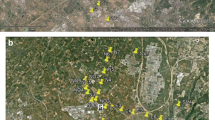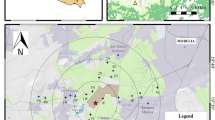Abstract
The ability of a transplanted lichen, Pseudovernia (P.) furfuracea, to act as a multi-tracer biomonitoring tool for As, Cd, Ni, Pb, 12 PAHs, 17 polychlorinated dibenzo-p-dioxins (PCDDs) and dibenzofurans (PCDFs) and 27 polychlorinated biphenyls (PCBs) was evaluated at six areas of varying risk (high, medium, negligible) of pollutant fallout from a municipal waste incinerator in central Italy. Transplanted P. furfuracea proved to be an useful tool to biomonitor PCDDs/Fs and PCBs. Concentrations of As, heavy metals, PAHs, PCDDs/Fs resulted similar for all monitored stations. Small differences in total PCBs (4378 and 4631 pg/g dw vs 3298, 4123, 3676 and 4022 pg/g dw) and dioxin-like PCBs (1235 and 1265 pg/g dw vs 794, 1069, 1106 and 1188 pg/g dw) were observed. Air concentrations of monitored compounds appear to be more related to general air pollution than point emissions from the incinerator.

Similar content being viewed by others
References
ARIANET (2004) FARM (Flexible Air Quality Regional Model)—Model formulation and user manual—version 2.2. Arianet Report R2004.04, Milano, Italy
Augusto S, Catarino F, Branquinho C (2007) Interpreting the dioxin and furan profiles in the lichen Ramalina canariensis Steiner for monitoring air pollution. Sci Total Environ 377:114–123
Augusto S, Máguas C, Branquinho C (2013) Guidelines for biomonitoring persistent organic pollutants (POPs), using lichens and aquatic mosses–a review. Environ Pollut 180:330–3388
Augusto S, Pinho P, Santos A, Botelho MJ, Palma-Oliveira J, Branquinho C (2015) Declining trends of PCDD/Fs in lichens over a decade in a Mediterranean area with multiple pollution sources. Sci Total Environ 508:95–100
Bargagli R, Nimis PL (2002) Guidelines for the use of epiphytic lichens as biomonitors of atmospheric deposition of trace elements. In: Nimis PL, Scheidegger C, Wolseley PA (eds) Monitoring with lichens: monitoring lichens. Kluwer Academic, Dordrecht, pp 295–299
Bergamaschi L, Rizzio E, Giaveri G, Loppi S, Gallorini M (2007) Comparison between the accumulation capacity of four lichen species transplanted to an urban site. Environ Pollut 148:468–476
Cabrerizo A, Dachs J, Barceló D, Jones KC (2012) Influence of organic matter content and human activities on the occurrence of organic pollutants in antarctic soils, lichens, grass, and mosses. Environ Sci Technol 46:1396–1405
Colombo A, Benfenati E, Bugatti SG, Lodi M, Mariani A, Musmeci L et al (2013) PCDD/Fs and PCBs in ambient air in a highly industrialized city in northern Italy. Chemosphere 90:2352–2357
Frati L, Brunialti G, Loppi S (2005) Problems related to lichen transplants to monitor trace element deposition in repeated surveys: a case study from central Italy. J Atmos Chem 52:221–230
Garty J, Perry AS, Mozel J (1982) Accumulation of polychlorinated biphenyls (PCBs) in the transplanted lichen Ramalina duriaei in air quality biomonitoring experiments. Nord J Bot 2:583–586
Godinho RM, Verburg TG, Freitas MC, Wolterbeek HT (2009) Accumulation of trace elements in the peripheral and central parts of two species of epiphytic lichens transplanted to a polluted site in Portugal. Environ Pollut 157:102–109
Guidotti M, Stella D, Dominici C, Blasi G, Owczarek M, Vitali M et al (2009) Monitoring of traffic-related pollution in a province of central Italy with transplanted lichen Pseudovernia furfuracea. Bull Environ Contam Toxicol 83:852–858
Guidotti M, Protano C, Dominici C, Chiavarini S, Cimino N, Vitali M (2013) Determination of selected polychlorinated dibenzo-p-dioxins/furans in marine sediments by the application of gas-chromatography-triple quadrupole mass spectrometry. Bull Environ Contam Toxicol 90:525–530
Holma-Suutari A, Ruokojärvi P, Laaksonen S, Kiviranta H, Nieminen M, Viluksela M et al (2014) Persistent organic pollutant levels in semi-domesticated reindeer (Rangifer tarandus tarandus L.), feed, lichen, blood, milk, placenta, foetus and calf. Sci Total Environ 476–477:125–135
Jacob J, Cherian J (2013) Review of environmental and human exposure to persistent organic pollutants. Asian Soc Sci 9:107–120
Kampa M, Castanas E (2008) Human health effects of air pollution. Environ Pollut 151:362–367
Malaspina P, Tixi S, Brunialti G, Frati L, Paoli L, Giordani P et al (2014) Biomonitoring urban air pollution using transplanted lichens: element concentrations across seasons. Environ Sci Pollut Res Int 21:12836–12842
Malcolm E, Keeler GJ, Lawson ST, Sherbatskoy TD (2003) Mercury and trace elements in cloud water and precipitation collected on Mt. Mansfield, Vermont. J Environ Monit 5:584–590
Muir DCG, Segstro MD, Welbourn PM, Toom D, Eisenreich SJ, Macdonald CR, Whelpdale DM (1993) Patterns of accumulation of airborne organochlorine contaminants in lichens from the upper Great Lakes region of Ontario. Environ Sci Technol 27:1201–1210
Park H, Lee S-H, Kim M, Kim J-H, Lim HS (2010) Polychlorinated biphenyl congeners in soils and lichens from King George Island, South Shetland Islands, Antarctica. Antarct Sci 22:31–38
Protano C, Guidotti M, Owczarek M, Fantozzi L, Blasi G, Vitali M (2014) Polycyclic aromatic hydrocarbons and metals in transplanted lichen (Pseudovernia furfuracea) at sites adjacent to a solid-waste landfill in central Italy. Arch Environ Contam Toxicol 66:471–481
USEPA (2007a) Method 8270D. Semivolatile organic compounds by gas chromatography/mass spectrometry (GC/MS) Rev 4. United States Environmental Protection Agency, Washington, DC. http://www.epa.gov/osw/hazard/testmethods/sw846/pdfs/8270d.pdf. Accessed 24 Apr 2015
USEPA (2007b) Method 8280B. Polychlorinated dibenzo-p-dioxins (PCDDs) and polychlorinated dibenzofurans (PCDFs) by high-resolution gas chromatography/low-resolution mass spectrometry (HRGC/LRMS). Rev 2. United States Environmental Protection Agency, Washington, DC. http://www.epa.gov/solidwaste/hazard/testmethods/sw846/pdfs/8280b.pdf Accessed 24 Apr 2015
Vallejo M, Fresnedo San Román M, Ortiz I, Irabien A (2015) Overview of the PCDD/Fs degradation potential and formation risk in the application of advanced oxidation processes (AOPs) to wastewater treatment. Chemosphere 118:44–56
Vilavert L, Nadal M, Mari M, Schuhmacher M, Domingo JL (2009) Modification of an environmental surveillance program to monitor PCDD/Fs and metals around a municipal solid waste incinerator. J Environ Sci Health A Tox Hazard Subst Environ Eng 44:1343–1352
World Health Organization (2007) Regional Office for Europe. Population health and waste management: scientific data and policy options. Report of a WHO workshop Rome, Italy. http://www.euro.who.int/__data/assets/pdf_file/0012/91101/E91021.pdf Accessed 25 Nov 2014
World Health Organization (2011) WHO Public Health and Environment Global Strategy Overview. http://www.who.int/phe/publications/PHE_2011_global_strategy_overview_2011.pdf?ua=1 Accessed 28 May 2015
Author information
Authors and Affiliations
Corresponding author
Rights and permissions
About this article
Cite this article
Protano, C., Owczarek, M., Fantozzi, L. et al. Transplanted Lichen Pseudovernia furfuracea as a Multi-Tracer Monitoring Tool Near a Solid Waste Incinerator in Italy: Assessment of Airborne Incinerator-Related Pollutants. Bull Environ Contam Toxicol 95, 644–653 (2015). https://doi.org/10.1007/s00128-015-1614-5
Received:
Accepted:
Published:
Issue Date:
DOI: https://doi.org/10.1007/s00128-015-1614-5




